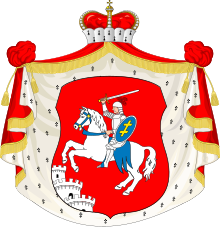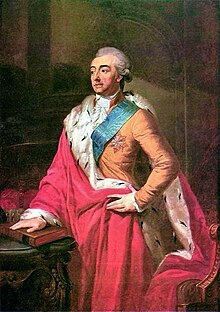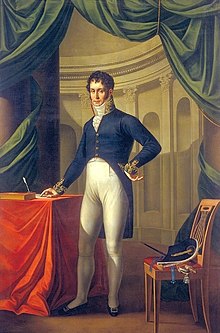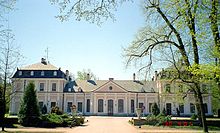Czartoryski (noble family)
Czartoryski ( Czartoryska is the feminine form) is the name of an important Polish - Lithuanian princely family, which traces its descent to Gediminas , Grand Duke of Lithuania († 1341).
history
The Czartoryski are among the most important noble families in Poland. The name Czartoryski is derived from the possession of Czartorysk in Volhynia . Konstanty Olgierowicz, Prince of Tschortoryjsk (1335–1390), son of Algirdas , Grand Duke of Lithuania, is considered the progenitor . He was a grandson of Grand Duke Gediminas and brother of the future Polish king Władysław II Jagiełło . The family was of particular political importance in the 18th century at the time of the Polish-Lithuanian Union ( First Rzeczpospolita ). In the 19th century, Prince Adam Jerzy Czartoryski, together with his younger brother, Prince Konstanty Adam Czartoryski , the military leader of the November uprising of 1830/1831, formed the head of Polish emigration in Western Europe.
The Parisian ancestral home of the Czartoryski family, the Hôtel Lambert on the Île Saint-Louis , developed into a center of social life in the French capital from the middle of the 19th century and in the following decades it became the center of political life for Polish emigration in the west Europe. The policy of the “ Hôtel Lambert ” was aimed at restoring Poland as a constitutional monarchy in accordance with the provisions of the Polish constitution of May 3, 1791 . Prince Adam Georg himself was planned to succeed the last king of Poland, Stanislaus II August Poniatowski , who abdicated in 1795 . The cultural leadership of the “Hôtel Lambert” during the 19th century is also undisputed. In addition to the greats of the Polish emigration such as Frédéric Chopin , Zygmunt Krasiński and Adam Mickiewicz , artists and writers such as George Sand , Honoré de Balzac , Hector Berlioz , Franz Liszt and Eugène Delacroix were regular guests of the royal family.
Family coat of arms
The coat of arms shows in red a strongly worded silver knight with golden spurs on a white (silver) jumping horse. In his right hand he carries a silver sword with a gold hilt over his head, in his left a blue shield with a gold Lorraine cross . The clasp of the silver scabbard of the sword is gold, the saddle and bridle of the horse are blue with gold decoration. A castle wall is depicted under the horse's hooves. The coat of arms is identical to the coat of arms of the Grand Duchy of Lithuania used as early as the 15th century .
Art collection
The noble Czartoryski family has built up one of the most important art collections in Poland over the centuries. In addition to works of fine art, including the world-famous painting Lady with an Ermine by Leonardo da Vinci , one of only four recognized autograph paintings by da Vinci, a further 86,000 museum objects and 250,000 books and manuscripts belong to it . The value of the collection is estimated at 2 billion euros. At the end of 2016, the Polish state acquired the entire collection for around EUR 100 million. In future it will be exhibited in the National Museum in Krakow.
Great personalities
Well-known representatives of this noble family, which still bears the title of prince, were among others:
- Prince Adam Kazimierz Czartoryski (1734-1823), son of Prince August Aleksander , was after the death of August III. as a candidate for the Polish throne, but was defeated by his cousin Stanislaus Poniatowski , whose election had received massive support from the Russian side. After the first partition of Poland, because of his possessions in Galicia, he entered Austrian service and was appointed field marshal by Emperor Josef II (HRR) . He took an eager interest in the Reichstag from 1788 to 1791 and in the efforts of the Polish nobility to restore independence to the fatherland, but sought in vain the Elector of Saxony to accept the crown of Poland and the Austrian Emperor to mediate the selfish intentions of Russia move. Appointed Senator Palatinus, he retired to his estate and died on March 22, 1823 in Sieniawa in Galicia. In 1761 he married his cousin Izabela, daughter of the Grand Treasurer of Lithuania, Georg Detlev Graf von Flemming . Izabela Czartoryska was equally famous for her spirit and her patriotism and was one of the most influential women of her age. After the death of her husband, she lived on her estate in Puławy , where, in addition to magnificent landscaped gardens, she also built elementary schools, factories and the first museum in Poland in the so-called Sibylle Temple. During the uprising of 1830 their castle was a hospital for the wounded and a refuge for the fleeing patriots. After the unfortunate outcome of the revolution, she retired to Wysock in Galicia, where she died on June 17, 1835. Her daughter, Princess Maria Anna , married Duke Ludwig von Württemberg in 1784.
- Prince Adam Jerzy Czartoryski (1770–1861) completed his education at the Universities of Edinburgh and London and took part in the struggle for freedom led by Tadeusz Kościuszko . After the third partition of Poland in 1795, together with his brother Constantine, he was sent hostage to Petersburg, where he became friendly with the young Grand Duke Alexander. After his accession to the throne, Alexander appointed him Minister of Foreign Affairs and curator of all educational institutions in Lithuania and Belarus. Adam Georg Czartoryski belonged to the so-called triumvirate that formed Alexander's personal council. He hoped through Alexander to restore an independent Poland under a Russian grand prince. He was therefore not in agreement with Russia's policy from 1805 to 1807, accompanied Alexander to the war, but after the war he was released without losing his confidence. Although he spoke in favor of his nation in the Russian Imperial Council shortly before the outbreak of war with France and his father openly joined Napoleon I, Adam Georg Czartoryski stayed at Alexander's side and received the dignity of Senator Palatine of the kingdom in 1815. At the Congress of Vienna he exerted significant influence on the drafting of the constitutional charter given to the Poles by Emperor Alexander. In 1817 he married Princess Anna Sapieha . As a member of the Senatorial Chamber at the First Reichstag, he spoke frankly of the advantages of constitutional constitutions and, as a curator of the University of Vilnius, tried to elevate the nationality of Poland, but in 1821 he was relieved of his position by Grand Duke Constantine, who distrusted him, and from then on lived on his Puławy headquarters only of the arts and sciences. After the outbreak of the Polish Revolution of 1830, he joined the Administrative Council in Warsaw at Lubecki's invitation, was appointed President of the Provisional Government and convened the Reichstag on December 18, 1830. On January 30, 1831, he chaired the Entrusted to the national government, he donated half of his fortune to save the fatherland, but resigned his office after the atrocities of August 15 and 16, 1831 and left Warsaw when Jan Krukowiecki had pushed himself to the head of the government and served as a meaner Soldier in General Ramorino's corps, until General Ramorino transferred to Austrian territory at the beginning of September 1831, after which Czartoryski also left Poland. Excluded from the amnesty of 1831, he lived in Paris from then on and was considered the head of the aristocratic (white) party of Polish emigrants, which saw him as the future constitutional king of Poland and formally elected him to it in 1838. His goods in Poland were confiscated. The sequestration imposed by the Austrian government on its properties in Galicia as a result of the Polish uprising of 1846 was lifted again in 1848. In April 1848 he released the peasants on his rule Sieniawa in Galicia from compulsory labor and gave them their possessions as their own. He was not reconciled with Russia under Alexander II and did not accept the amnesty offered to him in 1856. He died on July 15, 1861 at Montfermeil Castle near Paris. He left a daughter and two sons, Prince Witold Czartoryski (1824-1865) and Prince Władysław Czartoryski (1828-1894), the founder of the Czartoryski Museum in Cracow. In 1855 he married Marie Amparo, a daughter of Queen Christine of Spain. After the death of his first wife, he married Princess Marguerite of Orléans, daughter of the Duke of Nemours, in 1872.
- Prince Konstantin Adam Czartoryski , (1773-1860) went to Petersburg with his older brother, Adam Jerzy , after the second partition of Poland , at the request of the Empress Katharina in 1795 and joined the Guard here as an officer. Assigned to Grand Duke Constantine as adjutant general, he remained in Petersburg until 1799. He then returned to Puałwy and in 1801, after the death of Emperor Paul, went to Moscow for the coronation of Emperor Alexander. In 1803 he married Princess Aniela Radziwiłł , entered the Polish army in 1809, at the time of the Grand Duchy of Warsaw, under Prince Joseph Poniatowski and established a regiment at his own expense. After the death of his first wife (1808), Konstantin Czartoryski (1810) married Countess Maria Dzierzanowska and went to Paris in 1811. There he took part in the Russian campaign under Napoleon in 1812, took part in the battles near Smolensk and the Moskva (in the latter affair the horse was killed under his body by a cannonball) and was awarded the Officer's Cross of the Legion of Honor on this occasion Hand of Napoleon awarded. Because of ailments he left the service in 1813 and went traveling. In 1816, at the express request of the Emperor Alexander, he went to Petersburg and was appointed Imperial Adjutant General, but withdrew into private life in 1818 due to persistent sickness. After spending a few years alternately in Poland, France, Italy and Switzerland, he settled in Vienna in 1828. In 1832 he bought the Villa van der Nüll in Weinhaus near Vienna ( Czartoryski-Schlössel ) from the English ambassador Lord Cowley , which he furnished with a valuable collection of paintings, especially from the old Italian schools, and, as a real patron of the arts, made it a gathering point for the elite of the Viennese artistic world . Konstantin Adam Czartoryski died on April 23, 1860 in Vienna.


- Prince Constantin Adam Czartoryski ( Passy, Paris April 9, 1822– October 30, 1891 Vienna), lifelong member of the manor house (since 1867), member of the Imperial Court , last appointed by the emperor on March 26, 1891 as second vice president of the manor house.
- Prince Georg Konstantin Czartoryski (1828–1912) initially devoted himself to writing music and theater reviews. From 1855 to 1865 he and his brother Konstantin edited the “Reviews and Communications on Theater and Music”, a specialist journal that also enjoyed a good reputation outside of Austria. After the death of his father, he took over the important goods that came to him in Galicia. By introducing a more rational management based on the advances of modern times, by setting up factories and elementary schools, he made a significant contribution to raising the soil culture and improving the situation of the rural population in his district. Elected by the city of Jaroslau as a member of the Galician state parliament in 1867 , he soon gained significant political influence and is now a recognized leader of the federalist party in Galicia. In 1873 he was made a hereditary member of the Austrian manor house.
- Theodor II. Czartoryski , Archbishop of Poznan from 1739 to 1768
- Prince Władysław Czartoryski (1828–1894), son of Adam Jerzy Czartoryski , founder of the Czartoryski Museum in Cracow .
- Princess Izabella Czartoryska , née Countess von Flemming: writer, art collector and founder of the first Polish National Museum.
- Prince Michał Fryderyk Czartoryski (1696–1775), Grand Chancellor of Lithuania
- Prince August Aleksander Czartoryski (1697–1782), Voivode of Ruthenia, General-Starost of Podolia, Starost of Warsaw
Other personalities
- Adam Karol Czartoryski (* 1940), current head of the Czartoryski company
- Antonina Czartoryska (1728–1746), married to the Grand Treasurer of Lithuania, Georg Detlev Graf von Flemming
- Arkadiusz Czartoryski (* 1966), Polish politician
- August Czartoryski (1858–1893), prince, Roman Catholic priest and Salesian of Don Bosco
- Augustyn Józef Czartoryski (1907-1946)
- Eleonora Czartoryska , daughter of the Polish Grand Treasurer Wladislaus von Loß , married to Anton Dominik Czartoryski († 1695), then to Friedrich Wilhelm II. Von Holstein-Beck
- Elzbieta (Izabela) Czartoryska (1736–1816), married to the Grand Marshal of the Polish Crown, Prince Stanislaus Lubomirski
- Florian Kazimierz Czartoryski (1620–1674), Archbishop of Poznan from 1650 to 1654
- Idzizlaw Czartoryski (1859–1909), manor owner, member of the Reichstag
- Kazimierz Czartoryski (1674–1741)
- Konstancja Czartoryska (1700–1759), mother of the last Polish king Stanislaus II August Poniatowski
- Maria Anna Czartoryska (1768–1854), Polish writer
- Roman Czartoryski (1839–1887), German politician
- Władysław Czartoryski (1828–1894), son of Adam Jerzy Czartoryski, founder of the Czartoryski Museum in Cracow
- Theodor Kasimir Czartoryski (1704–1768), Bishop of Posen
Previous possessions


- Palace of the Czartoryski Princes in Puławy . In 1782 the settlement became the property of Prince Adam Kazimierz Czartoryski and soon became an important center of political and cultural life in Poland. In 1801 the first museum in Poland was opened on the initiative of Princess Izabella Czartoryska . There were u. a. also List of paintings by Leonardo da Vinci on display. Parts of the painting collection are now exhibited in the Muzeum Czartoryskich in Kraków , the oldest museum in Poland.
- Gołuchów Castle : until 1945 owned by the Czartoryski family. The castle, a right-angled fortification with corner towers, is a complex from the heyday of the Renaissance and was built in 1550–1560 under the leadership of Rafał Leszczyński (voivode in Kujawy) as an extension of an already existing aristocratic residence. Up until 1939 Gołuchów Castle was one of the largest private museums in Europe, and the collections were saved from the Nazis during the occupation by the German Reich 1939–1945. The National Museum in Poznan has been the owner since 1952 , and the castle is still in operation today as a branch.
- Sieniawa Castle : The castle was built in the 18th century by order of the Crown Grand Hetman Adam Nikolaus Sieniawski. In 1731, when Princess Maria Zofia Sieniawska married Prince August Aleksander Czartoryski, the town became the property of the Czartoryski family, who belonged to Sieniawa until 1944.
- Wilanów Palace near Warsaw: In the years 1677–1696 on behalf of King Jan III. Sobieski built. The palace was owned by the Czartoryski family in the second half of the 18th century.
- Czartoryski Palace in Krakow : The palace is now home to the Czartoryski Museum , the oldest museum in Poland. The art collection was founded in 1796 by Princess Izabella Czartoryska .
- Rokosowo Castle: The castle was built in the middle of the 19th century in the romantic Gothic style based on a design by the architect Friedrich Stüller for Count Józef Mycielski. The castle stands on the site of an old manor house from the 16th century, the existing moat is a remnant of the earlier system. The castle is surrounded by a 10 hectare park that was created based on the existing natural landscape. In 1867 the Czartoryski family bought the property and owned it until the Second World War . Today there is a hotel in the castle.
- Czartoryski-Schlössel , a former palace in Vienna's 18th district of Währing .
- Hôtel Lambert , Palais in Paris, which was owned by the family from 1842 to 1975 and became an important center of the Poles in exile.
literature
- Constantin von Wurzbach : Czartoryski, the family, genealogy . In: Biographisches Lexikon des Kaiserthums Oesterreich . 3rd part. Typogr.-literar.-artist publishing house. Establishment (L. C. Zamarski, C. Dittmarsch & Comp.), Vienna 1858, p. 88 ( digitized version ).
- Czartoryiski . In: Meyers Konversations-Lexikon . 4th edition. Volume 4, Verlag des Bibliographisches Institut, Leipzig / Vienna 1885–1892, p. 391.
- Czartoryski (Constantine, Prince) . In: Brockhaus Konversations-Lexikon 1894–1896, Volume 4, p. 664.
- Marcin K. Schirmer: Arystokracja. Polskie Rody. Wydawnictwo Naukowe PWN, Warsaw 2012, ISBN 978-83-01-16955-8 , p. 122.
Web links
- House of Czartoryski
- Czartoryski Museum . National Museum Krakow






